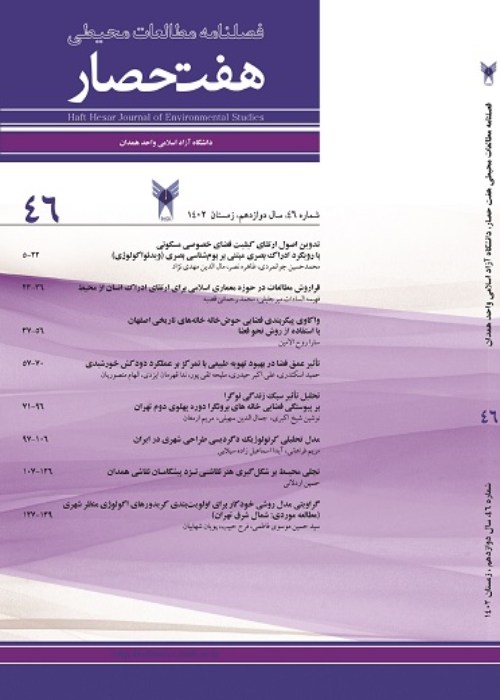An investigation about the necessity of relationship In-Between spaces on a large scale with a transitional characteristic (Case study: transitional space in four public samples)
Changing a space to a place is the existential purpose of architecture. Literature review regards the complex architectural organization as a significant factor for the maximum use of the individualschr('39') performances and activities. Due to exterior spaceschr('39') necessity beside the interior ones, the architect creates a third space; and due to this in-between space, the complexchr('39')s spatial organization is formed. Sometimes it is determined in the form of a boundary, sometimes is manifested in the form of a room. In any case, like a joint, the interstitial space makes possible the separation or connection between two areas. By the in-between space on a large scale (public arena) with transitional property in this research, we mean a hierarchy of intermediate spaces from exterior spaces to the buildingchr('39')s interior spaces. In a proposed model, the transitional space has divided into four entry areas: pause and gathering space, communication motor space, and transitional visual space. The use of these spaces affects people differently compared to the complete inside and outside space. The main question is: what factors affect the transitional spacechr('39')s quality as the interstitial space in the spatial formation of a building given the public arena? What strategies will improve the nature and quality of this space in the physical elements of the architecture? For the case study, the researchers select the four public complexes, two exterior samples (The national center for the contemporary arts of Fresno and the student center of Alfred Lerner Hall, New York University) and two interior samples (Tehran Bar Association, and Mellat Cinema Complex) with the highest level of benefit from the interstitial characteristics. This research defines a qualitative study based on rational reasoning and description, explanation, and interpretation. Five architects completed a qualitative questionnaire that includes appropriate strategies to improve the desired spatial quality with an interstitial concept according to the formation criteria. The article presents a table as a design solution. The research findings show that the transitional spaces as the in-between spaces are a practical approach to connect or separate two exterior and interior spaces and improve the desired spatial quality.
- حق عضویت دریافتی صرف حمایت از نشریات عضو و نگهداری، تکمیل و توسعه مگیران میشود.
- پرداخت حق اشتراک و دانلود مقالات اجازه بازنشر آن در سایر رسانههای چاپی و دیجیتال را به کاربر نمیدهد.


